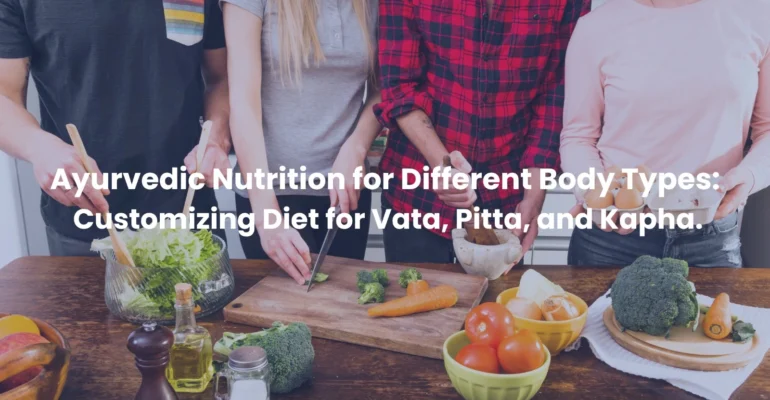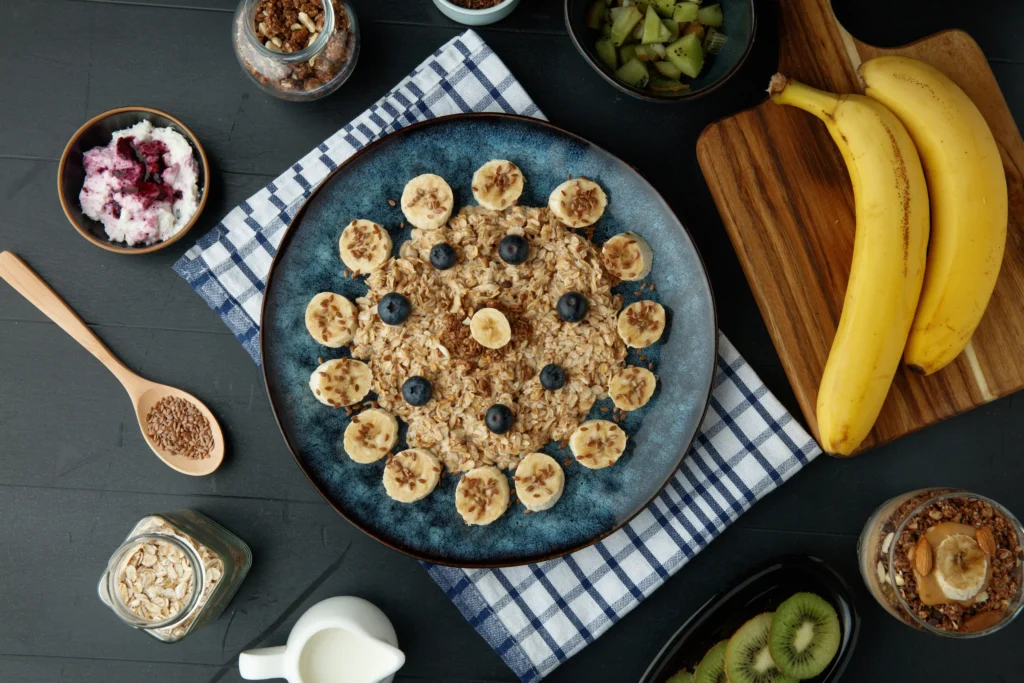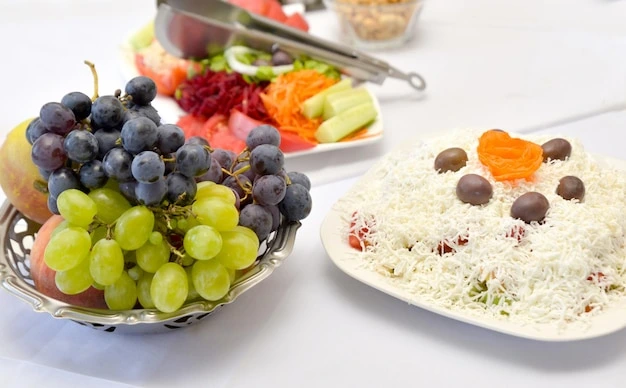Ayurvedic Nutrition for Different Body Types: Customizing Diet for Vata, Pitta, and Kapha.

Ayurvedic Nutrition for Different Body Types: Customizing Diet for Vata, Pitta, and Kapha.
Delving into how personalized diets based on dosha types can optimize health.
- Me and my friend working at the same place with the same shift timings and have similar canteen food everyday but I am having severe acidity, heartburn, headache but he is totally fine. How is it possible?
- What diet and lifestyle should I follow to keep my dosha in a balanced state? Does following these diet and lifestyle measures help me prevent diseases?
Ayurveda emphasizes on identifying individual prakruti for maintaining health harmony by appropriate diet and lifestyle.
What is Prakruti / Body Types?
Prakruti is an inherent nature of an individual determined at the time of your birth, which can not be changed during your lifetime. Ayurveda broadly classifies human nature in two types – Mental and Physical Nature.
There are 7 types of Sharir Prakruti:
- Vata Prakruti
- Pitta Prakruti
- Kapha Prakruti
- Vata Pitta Prakruti
- Pitta Kapha Prakruti
- Kapha Vata Prakruti
- Tridosha
![]()
Each Prakruti has different characteristic features. The concept of Prakruti makes Ayurveda unique from other medical systems. Selection of treatment, medicine is different for each individual depending upon their Prakruti. Ayurveda also suggests food which is conductive, foods which need to be avoided according to Prakruti. Assessment of Prakruti analysis will not only help in understanding the physical and mental constitution of patients, but also plays a vital role in prognosis, diagnosis, treatment and prevention of many diseases.
Significance of assessment of prakruti:
Every living creature has all three doshas within them. We cannot exist without a certain amount of each. Our constitution is best defined in terms of the percentage of each energy within a person’s constitution.
To know a person’s constitution is to know their tendencies. If a person knows their tendencies they can take the actions that keep their tendencies in check. A person who knows that they have a tendency to feel cold, easily avoids becoming too cold by wearing more clothing or drinking warm beverages. To know your constitutional tendencies is to be empowered with the knowledge needed to create balance in your life.
According to Ayurveda, following a suitable diet and lifestyle based on your Prakruti helps you keep your doshas balanced and protects you from diseases.
Prakruti determines one’s susceptibility to various diseases. For example, a person of Vata prakruti is more prone to diseases arising from aggravation of vata dosha viz. arthritis, cracked feet, numbness in body, paraplegia, tachycardia, insomnia, anxiety disorders etc.
The knowledge of prakruti also enables one to design an individualistic lifestyle that will prevent the origin of diseases in the body. Parkruti also tells about prognosis of diseases and the most suited treatment modalities leading to enhanced level of drug efficacy.
Diet For Vata Prakruti:
Vata prakruti individuals may either be very tall or relatively small, with a low weight and delicate bone structure. Their muscles are usually underdeveloped, rendering them less strong.
Their skin is characteristically dry, rough, and cool. Also, they have dry hair and brittle nails.
Weight fluctuations are common, as Vata types tend to gain and lose weight quickly.
- Vata types benefit from consuming foods that possess the following properties: warmth, oiliness, static nature, sliminess, heat, slowness, softness, and liquidity. These characteristics counteract the air qualities that are inherent in Vata types.
- Proper nutrition for the Vata type entails consuming small, regular meals and avoiding excessive food combinations. Taking the time to eat and thoroughly chewing food allows for the release of pre-existing digestive enzymes in the saliva, facilitating easier digestion.

- Hydration is crucial for Vata types, with an emphasis on drinking regularly and abundantly. Warm drinks are especially beneficial. Additionally, meals should consist mainly of warm dishes, with vegetables generally being cooked. Sweet and warming foods help to balance Vata.
- For the Vata type, warming spices like pepper, ginger, and cardamom are highly recommended.
- Opt for sweet fruits such as bananas, coconuts, apples, figs, grapefruits, grapes, mangos, melons, papayas, peaches, pineapples, plums, various berries, cherries, apricots, and avocados.
- Ensure that vegetables are thoroughly cooked and consumed warm. Choose from options such as green beans, carrots, okra, beetroot, celeriac, asparagus, and sweet potatoes. Rice, ragi, and oats are suitable grain options.
- Include ghee, milk, paneer in your diet.
Food to be avoided:
- Stimulating beverages such as cola, coffee, and black tea should be avoided by the Vata type due to their excessive stimulation of the nervous system. Whenever possible, carbonated drinks should also be avoided.
- Always make sure that you have got enough fat content in your diet. Avoid dry, stale food.
- Prefer eating warm and freshly prepared foods. Foods directly from the refrigerator are not good for Vata dosha.
- Avoid bitter, astringent, or pungent (spicy foods/ingredients) taste in your diet. For example – millets, certain varieties of fish, dry fish, etc. You can include them once in a while in your diet. But not advisable for regular meals.
Lifestyle activities for Vata prakruti:
Regular oil massage greatly helps Vata people for their entire life. Apart from this, Vata Prakruti can also practice oil pulling or adding oil to nostrils, etc. for better health.
Involve yourself in strength training, sports, and swimming rather than cardio workouts.
Never stay awake for a long time at night.
Diet for Pitta prakruti:
People with a predominant Pitta constitution tend to have a medium build, strong appetite, sharp intellect, and leadership qualities when in balance. They are ambitious, focused, and enjoy challenges but may also be prone to perfectionism and overwork.
However, the body may witness unusual changes when the Pitta dosha levels risbody.
- Include foods/ingredients that are sweet, bitter, and astringent in your diet. Naturally, those with pitta prakruti have a higher body temperature. So reducing hot and spicy foods and foods with a lot of salt and sour taste is good for your health.

- Apples (sweet), ripe grapes, milk, ghee, melon, plum, asparagus, leafy greens, cabbage, cucumber, cauliflower, and bell pepper should be a part of the diet.
- Legumes can be helpful, including lentils, split peas, soybeans, black beans, and wheat.
- Almonds, pumpkin seeds, coconut, and sunflower seeds can also help manage Pitta levels.
- Include food items that are cool, both energetically as well as in temperature.
- Try to opt for organic fruits and vegetables.
Food to be avoided:
- Avoid chilies or foods that are too spicy such as pickles, etc. Also, avoid too much of oily foods.
- Avoid items like yogurt, vinegar, and fermented foods that have a tendency to increase the Pitta in the body.
- Avoid food items that are pungent, sour, and salty.
- Avoid caffeine, nicotine, or any other stimulants.
- Canned and processed foods should be avoided as they contain preservatives and artificial additives. They are also heavy on salt and sour tastes.
Lifestyle activities for Pitta prakruti:
Always keep your anger, irritation, stress/tension under control.
Listening to calming music or performing fine art activities helps in keeping Pitta in balance.Spiritual involvement helps in balancing Pitta dosha more than Vata or Kapha dosha.
Some Pitta-types have specifically a strong digestive fire and find that they can endure more food variety than others.
Diet for Kapha prakruti:
The frame of the Kapha body is usually large. It appears to be compact and well developed, with rounded joints and a big, strong bone structure. The kapha body has a tendency to gain weight easily. People with this dosha have lustrous and oily skin, which is fair and cool, owing to the properties of the water element. Kapha hair is usually strong, coarse and curly. They have deep set, dark eyes.
- Bitter, pungent, and astringent are recommended tastes for people for Kapha prakruti. Diet should be included with food/ingredients that are bitter, pungent, and astringent in taste. Reduce your intake of foods that taste sweet and sour in your regular meal.
- Mung bean, Rice & Wheat older than one year, Barley, Little millet (samai), Finger millet (kezhvaragu/ragi), Pearl millet (kambu), Buttermilk, Bitter tasting leafy vegetables, Sweet potato, Elephant foot yam (senai kilangu), etc. are recommended.
- Make sure that you include a lot of fibre content in your diet.
- Replacing white rice with brown rice once in a while, along with barley and wheat bran can help balance the kapha.
- Apart from this, include these ingredients in your regular diet – ginger, cumin seeds (jeera), carom seeds (omam), turmeric, and cloves.
Food to be avoided in Kapha prakruti people:
- To prevent aggravation of kapha, avoiding sweet foods is advisable. Sweet foods can provoke the kapha, as they are heavy and oily, and inherently moist. This implies not just to foods containing refined sugar and processed products, but naturally sweet tasting foods like root vegetables and nuts. Sweet foods not only trigger a physiological imbalance in the kapha but also cause lethargy and excessive sleep, leading to lack of motivation. Foods containing a very high moisture level should be taken with a lot of caution as well. Very sour fruits and foods, as well as those that are cooked In excess oil, and high in protein must be avoided.

Lifestyle activities for Kapha prakriti:
Always keep yourself active. It is very important for Kapha dosha.
Avoid a sedentary lifestyle, daytime sleep, taking too much rest, and keeping your mind idle. This can even stimulate metabolic disorders in people with Kapha prakriti.
Exposure to sunlight is very much needed for Kapha. Keep your brain engaged with lots of productive work.
Prakruti and way of life:
The first step in personalized Ayurvedic nutrition is identifying your primary dosha. This can be done through self-assessment questionnaires or consultations with an Ayurvedic practitioner. Understanding your dosha helps you tailor your diet to maintain balance and health.
Ayurveda provides specific dietary guidelines for individual prakruti and also for particular vitiated dosha, aiming to balance their unique characteristics.
It’s like a fingerprint, as unique as you are. Understanding your prakruti and probable health problems guides you toward the perfect diet, exercise routine, and daily habits that resonate with your body’s natural rhythm. So, it’s time to forget the one-size-fits-all approaches. Prakruti will help you personalize your path to well-being
Ayurveda focuses on establishing the equilibrium of tridosha within the body. Adopting the guiding principles related to food and nutrition according to prakruti for maintaining a proper state of health of the body are very important. It not only includes specific diet but also it includes personalized lifestyle, moral, and seasonal conduct. Adhering to food and lifestyle recommendations based on prakruti will lead to dosha harmony and good Quality of Life.
Every individual should be aware of their prakruti in order to choose a healthy way of living and eating habits they should follow to maintain their health. This will serve as a key for maintaining a healthy life.
Author: Dr. Gayatri Kulkarni – Mulye
MD ( Ayurved)
Special proficiency in Gynecological disorders and Infertility.
Practicing since 12 years at Orthoved hospital, Dombivli,
For regular updates, like and follow:

